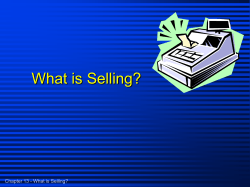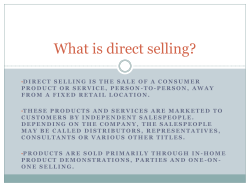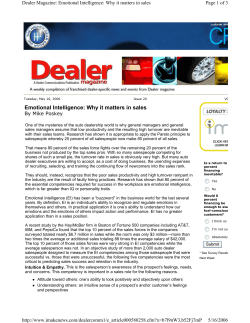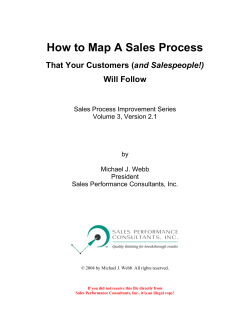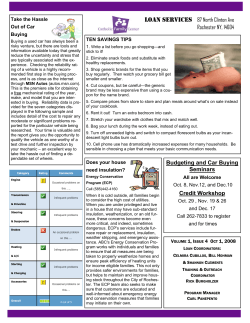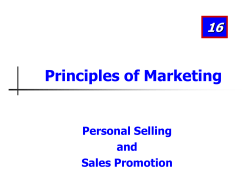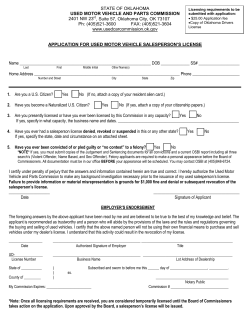
Introduction Me PLC How to use The Key to Successful Selling
10 How to use The Key to Successful Selling 14 How to behave like a professional salesperson 18 Human attitudes and everyday behavior are the foundation for professional sales. The most successful salespeople possess a number of human attributes that give them the drive that generates positive results. The born salesperson The professional dream-maker The super-seller The importance of rapport Always on the job Authority Business sense Knowledge All quiet on the home front Self-esteem Working conditions Sales attitude Aggressive waiting Loyal customers Active selling There are no difficult districts The active salesperson is selective The salesperson of the future Basic characteristics Knowing your competitors The need for innovative thinking Business sense 18 18 18 20 20 20 20 20 21 21 21 22 22 23 23 23 24 24 24 25 26 26 Me PLC 28 Team player Self-starter Energy Enthusiasm Make room for enthusiasm Be enthusiastic about winning Enthusiastic salespeople find life easier Optimism Fighting fit The will to change Motivation What motivates you? Knowing your job Knowing your product Creative thinking Salespeople must master the six thinking hats 30 30 31 31 31 32 32 33 33 33 34 35 35 36 36 36 Success 40 Pride Success criteria What should be quantified? How do you work with criteria for success? Other types of success criteria Professional skills Define the salesperson’s limitation Instruction and learning Profit-related pay Ambition A holistic view of life Prioritization Put it down on paper Spend a little longer every day Results 41 41 41 42 42 42 43 43 43 43 44 45 45 45 47 3 Content Introduction 4 Content What the customer wants from you 48 Empathy Flexibility Efficiency Expertise Honesty Respect Trust The modern merchant The open-book principle Service and quality – there’s money in them The bargain Costs of poor service Who is there for whom? Internal marketing Deaf for 2,000 years The 10 service commandments Buyers’ likes and dislikes 49 49 49 50 50 50 50 50 51 51 51 52 52 53 53 53 54 Tools of the trade 56 In the ABC of the sale, you have a tool you can use to plan and execute the sales process. You need to know what the customer will say yes to, how to deal with objections and how to follow up. But you also need to be aware of how to put financial arguments, if you are to achieve positive results for yourself and your company. Some concepts People to people Retail sales Project sales Strategic selling Customers Advice customers Partner customers Everybody shares responsibility for sales 57 57 58 58 58 59 60 60 61 Targeted sales 61 Phases of strategic selling 62 Pre-sale 62 During the sale 63 Post-sale 63 Lead selection 64 Processing the lead 65 Sales letter 65 Follow-up 66 Telephone follow-up using the AIMS method 66 What impressed you most? 67 Preparing and holding the first meeting 69 Minutes and thank-you letter 69 Sales offer and preparation for second meeting 69 Second meeting – presentation of offer or solution 70 Acceptance and order confirmation 70 Detailed planning – operations 70 Planning and delivery 70 Week-after meeting – follow-up and checking 71 Status meeting – maintenance and added sales 71 Consolidation and expansion of customer relationship 71 Always be top of mind 72 The ABC of the sale 76 Simplicity works Systematic sales 77 77 Attention 80 The decision-maker’s desk Opening technique Get the customer to say something positive Link openings Question openings Demonstrations News 82 83 83 83 83 83 84 86 Motive for buying Savings Utility Safety Health Pleasure Recognition Prestige Consideration for others Sense of security Sense of belonging Recognize buying motives The saver The handyman The safety-conscious The prestige type The security conscious Solidarity on the road Every customer has a different buying motive The power of you Argumentation techniques Case histories and references Why buy from you? FAB form/PFB form What’s in it for me? Give at least five reasons to say yes How to use a FAB form Active listening Interview technique Advice on interview technique Questions Closed questions Open questions Five types of question Information questions Research questions 87 88 88 88 88 88 89 89 89 89 89 89 89 89 90 90 90 90 90 90 90 91 91 91 92 92 92 93 94 94 96 97 97 97 97 98 Hacker questions Interpretative questions Challenging questions Decision questions Buying signals How to respond to buying signals Buying signals in retail sales Objections and customer resistance How to deal with objections Welcome objections Don’t ignore objections Don’t contradict Don’t ask why Don’t interrupt Don’t agree with them Don’t argue Dealing with objections Address emotion first, reason later How to handle objections The customer is doing business with a competitor The customer doesn’t like the color Price objections Hold the price back until the end Critical questions and answers Objections indicate interest Complaints Always be loyal 98 99 99 100 100 101 101 102 102 102 103 103 103 104 104 104 104 105 105 105 105 105 106 106 106 106 107 Closing 108 Closure is not always an order Ways to close a deal Summarizing Alternatives References Isolation Reserve argument Added value 109 110 110 110 110 110 111 112 5 Content Benefit 6 Content Fear 112 Cold calling 114 New business and prospecting Spend time on prospecting Planned and focused Salespeople must be in charge of all sales phases Donut sellers Pharmaceutical consultants and prospectors Adjust to circumstances Dress There are prospects out there The right contact First contact Always follow up Making an offer Changing partners is tough Phone deals The AIMS method Example of AIMS Planning the first meeting Delays and problems 115 115 115 115 116 116 116 116 116 117 117 117 117 117 118 118 119 119 121 Meetings 122 The right presentation Preparation Agenda Be prepared and relaxed Talk about the customer – not about yourself Minutes Added value Using your time well Preparation Pre-meeting During the meeting After the meeting 123 123 124 124 124 124 124 124 125 125 125 126 Quantification Note-taking technique Some tips for note-taking Negotiation technique Sales negotiations The negotiating framework Preparation Sources of pressure 127 127 127 128 129 130 131 132 Presentations and demonstrations 134 Impact Basic rules Body language Ask questions and listen actively Outline plan Introduction Assertion Reasoning Examples Head off objections Conclusion Stagecraft Tact Unequivocal Humor Materials Audiovisual aids Energy Ethical standards Dealing with difficult participants Preventing difficulties arising Participation – group work Main rules for group work Self-evaluation Participant evaluation Exhibitions Setting up the stand 135 136 136 136 139 139 139 140 140 140 140 141 141 141 141 141 141 142 142 142 143 143 144 144 144 144 145 What are you selling, and what is the customer buying? Receiving complaints Good friends and old customers The media A crowded stand Competitors Sales technique on the stand Contact opportunities on the stand Materials on the stand Follow-up Your personal objectives Personal preparation Discipline on the stand Dress and appearance Good manners on the stand 145 145 145 145 145 145 145 146 146 146 146 146 147 147 147 Communication 148 Speak to fundamental interests Relationships Basic rules Formulating your message There is always a reason Relationships Some good advice Know your subject Be positive Written communication Who am I writing to? Sentences When you have finished Rix Active voice Metaphors Sales letters Unspoken questions Meeting confirmation Minutes 149 149 149 150 150 150 150 150 151 151 151 152 153 153 153 153 154 156 158 158 Negotiation minutes Decision minutes Offer Order confirmation Complaints Nine rules for handling complaints Relationships Sales and service by phone The first few seconds Gain confidence Complaints Avoid hold times Be accommodating Listen Language Keep appointments, deals and promises Loyalty When you call Body language Be aware of body language Interpreting and misinterpreting Notice changes Barriers to communication 158 158 160 162 165 165 168 168 170 170 170 170 170 170 171 171 171 171 172 172 173 174 175 Marketing 176 External marketing Internal marketing Personal sales and personal marketing 177 178 179 Finance and financial discussion 180 Pay according to profit contribution Costs Planning visits Sales costs Think of them as your own costs Business sense 181 181 181 181 182 182 7 Content Financial argumentation Credit Profitability Average purchase per transaction The great law of small figures Shifting focus and sales management Use of resources Efficient credit controllers/salespeople Loyalty 183 184 184 187 187 187 187 188 189 The salesperson’s development potential 190 The development of your selling skills is closely linked to ongoing learning. This section also contains plenty of good advice for managers on how to improve sales and service, for example by customer relationship management (CRM). 8 Content Positive attitude and enthusiasm Change means altering habits 10 commandments for all employees 10 commandments for managers Difficult customers/employees 10 ways to improve the management of your store 10 ways to improve sales in your store 10 ways to improve service in your store 191 192 192 193 195 196 197 197 Customer relationship management (CRM) 198 The CRM concept CRM alone does not bring success Changes in day-to-day work Built-in conflict Ways to change attitudes and behavior Implementing CRM requires insight CRM must take root 199 199 200 200 201 202 203 Learning and development 204 Action plans Contents of an action plan Coaching Learned helplessness Mentoring Courses Training and learning – every day Learning for the future Blended learning Demand for good blended learning Three minimum requirements This is blended learning 205 205 206 206 206 207 207 208 209 209 210 210 About the author 212 List of illustrations 214 Index 220
© Copyright 2025
